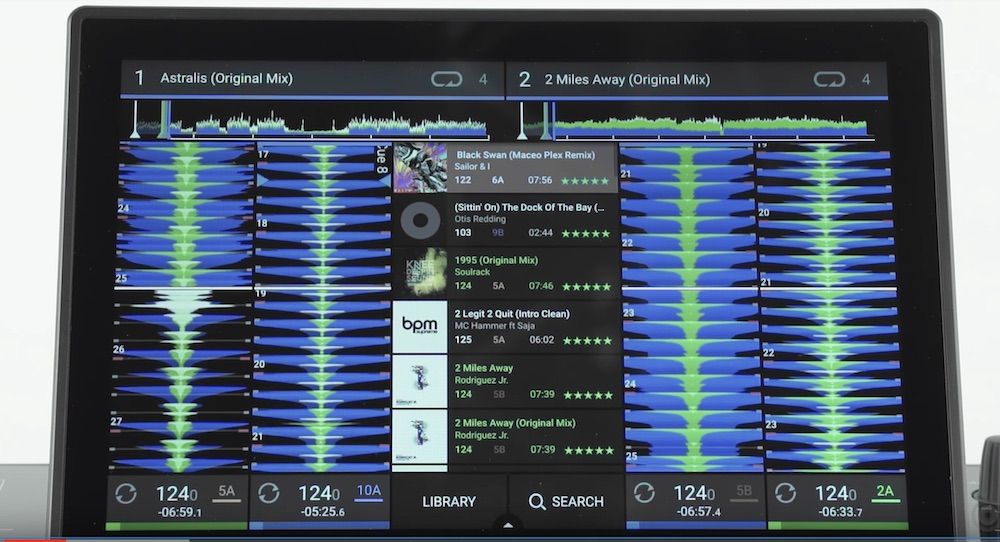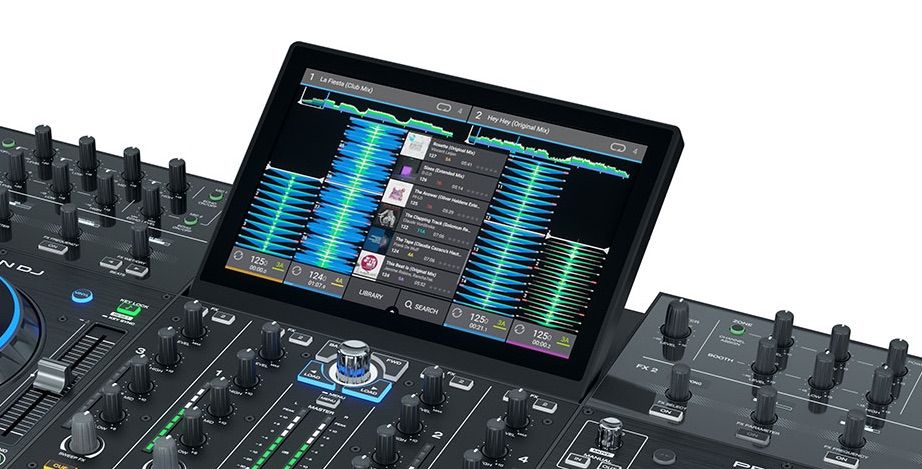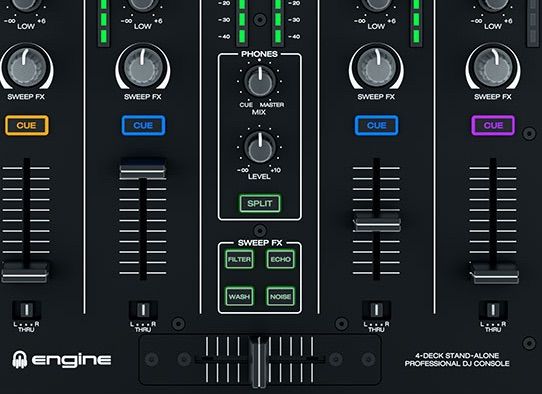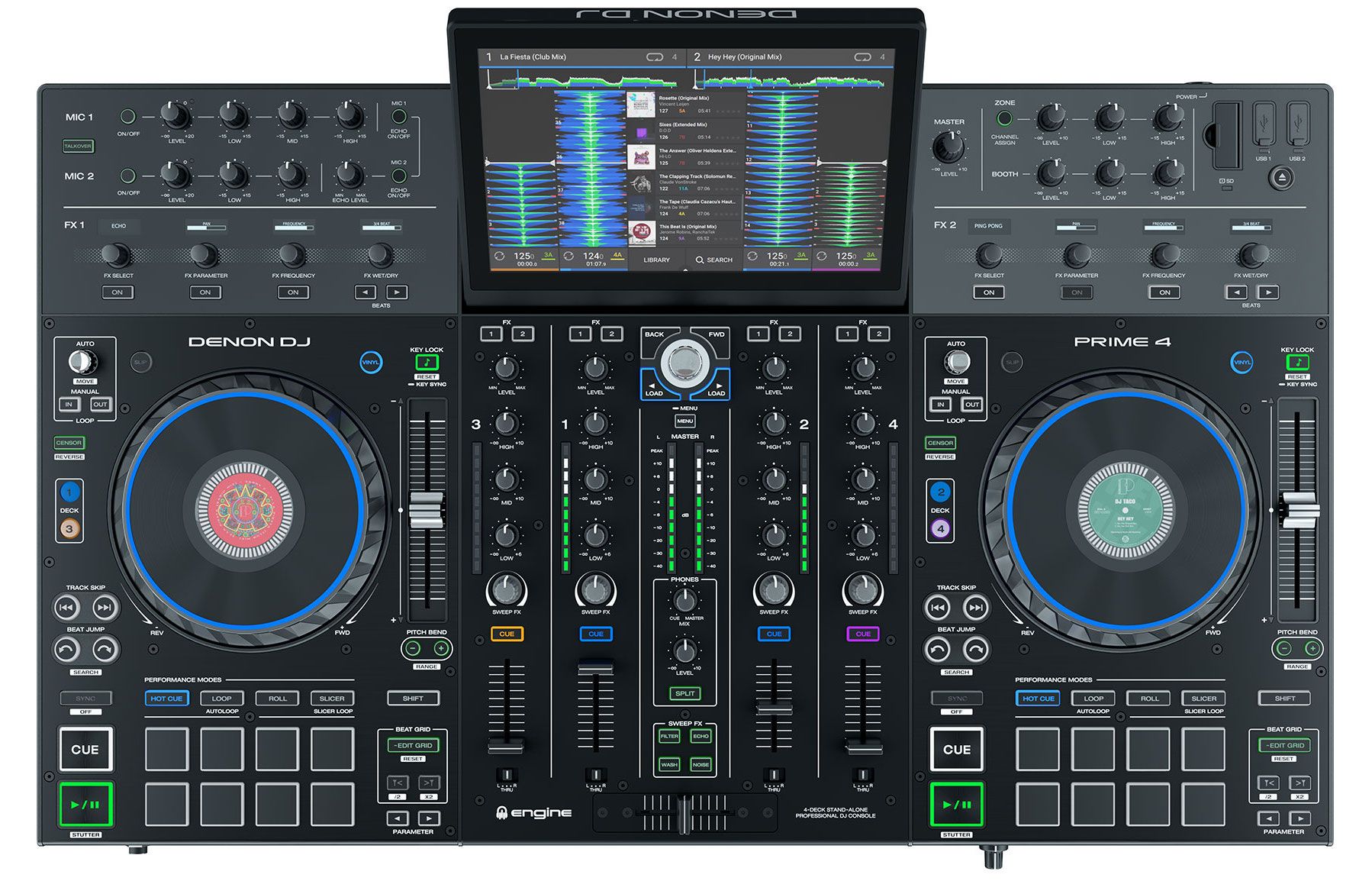Denon DJ has just announced Prime 4, a standalone DJ rig with four internal decks, a large 10″ tilting touchscreen, a built-in hard drive, a second “zone” of audio output, and many more features. Learn more about the Prime 4 in this article.
Denon DJ Prime 4
- Gear: Prime 4
- Manufacturer: Denon DJ (owned by InMusic)
- Price: $1,699
- Availability: March 2019 (pre-order from the DJTT shop)
DJs have been asking for a four-channel standalone DJ unit for a long time. We constantly hear from customers who want a standalone S4 with Traktor built-in, or a four deck XDJ-RX. Yes, the old MCX8000 had four channels, but it could only play two decks of tracks.
The new Prime 4 represents all the best features of Denon DJ’s digital Prime ecosystem from the SC5000s, but all combined into one unit. It also touts some industry firsts – and until Pioneer DJ or another manufacturer fires back, it is unparalleled in what it offers for the price. Get primed for the feature highlights, below:
Four Deck Engine Prime DJ software

Engine Prime’s standalone install on the SC5000s is pretty much rock solid these days, running two layers of audio on each player. The Prime 4 will have four decks of playing audio on the built-in software. We don’t yet know too much about how the software works, but here’s what we know so far:
- Four decks arranged vertically (press photos don’t show a horizontal mode, but it probably is here too) with a library section in the middle
- Key syncing – meaning you can quickly pitch shift songs to match (a feature we’ve seen on Virtual DJ, Serato DJ, but never a standalone unit)
- Full lossless file support (FLAC, ALAC, and WAV)
- USB keyboard support for easy searching
- StagelinQ compatible (for lighting or visuals integration – see this new video showing off Prime units controlling Resolume)
Tilting 10-inch Touch Screen

This screen is on the large side for a standalone unit, but honestly, the displays on CDJs and XDJs leave something to be desired. Beyond that, you need the extra real estate to reasonably see four decks on it – any smaller and we’d be sacrificing visibility.
It’s a multi-touch screen, meaning you can use a lot of the same swiping gesture controls as on the SC5000s – pinching to zoom, swiping tracks onto decks, scrolling through tracks quickly. This is a welcome reprieve from the XDJ-RX2 which has a touch screen but doesn’t seem to use it for most types of control.
“Dual Zone” Audio Output (for a second room?)
This one is a strange choice, but I’m down with the flexibility that it gives mobile DJs: the ability to send a deck to a second set of XLR outputs on the back of the unit.

Based on the press release and controls on the unit, it seems like you can send one of the four decks to the Zone Out XLRs, and set playlist to play out on that second channel. Notice the “Zone Channel Assign” button in the top right of the Prime 4:

4 USB slots, SD Slot and 2.5 SATA drive bay
This has got to be the most amazing selection of inputs we’ve seen, ever, on a standalone piece of gear. The SC5000s were impressive, but the Prime 4 has:
- 2 USB slots on the top
- 1 SD card slot on the top
- 2 additional USB slots on the rear
- a 2.5″ SATA drive bay (maybe accessed from the bottom?) to store music onboard
Oh, one more thing here: you can hit record and start recording a mix on any of the connected drives or cards. Again, this is another area where Pioneer DJ seriously limited DJs on XDJ-RX/2 units by only allowing one of their two USB slots to be the Record Out slot.
Sweep FX and Dual Beat FX units
The dual-pole Sweep Effects on each channel have the expected workflow of control, although it is a bit of an odd choice to put the selector right in the middle of the mixing section, above the crossfader and between the channel strips. It makes that section feel really crowded in these initial images.

The Sweep FX offered are Filter, Echo, Wash, and Noise – all very useful. Worth noting that there is no parameter control for these, which means the resonance of these FX will not be easily controllable on the fly.

The Beat FX are a departure from the traditional model in terms of workflow. There are two FX units, one above each deck, and are assigned using buttons above each channel strip. There are four encoders for each unit, each with buttons below them for additional control, and small screens above to show what you’re controlling.
- FX Select – to select the effect used
- FX Parameter – to tweak a key parameter of the effect)
- FX Frequency – to apply the effect to specific frequencies of the audio
- FX Wet/Dry
Performance Pads (duh)

It wouldn’t be a new piece of DJ gear in 2019 if it didn’t have at least eight pads per deck on it, right? The Performance modes are exactly what you would expect:
- Hot Cues
- Loop and Autoloop
- Roll
- Slicer and Slicer Loop
A Few More Features That Are Rad
- Four assignable input channels for other audio sources
- 6-inch jogwheels with that same on-jog display for showing off album artwork
- 2 XLR inputs for mics
- Cross fader curve contour control
- Fader Start
- Onboard track analysis – and according to the video, the Rekordbox import functionality that was introduced on the SC5000s will be present here. They note it is “quick and easy” – which certainly wasn’t the case with large Rekordbox drives in the past when you first imported them, but things have likely improved.
- “Coming Soon | Serato DJ Pro control enabled” – we’re not sure what degree of control and integration this will have, but this seems like a big story for another day…
Look At That Price Tag
In a very clever move, Denon DJ has also decided to price the Prime 4 at the exact same price as Pioneer DJ’s XDJ-RX2: $1,699. If the unit delivers on the feature set, this represents a very compelling decision for DJs looking for a home setup. It also explains exactly why the SC5000 price was chopped late last year to $999.
We’ll see it at NAMM next week! Stay tuned to all of the NAMM news on DJTT here.
If you have questions about this unit, ask in the comments and we’ll get it answered.






